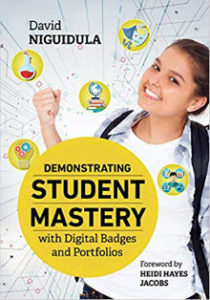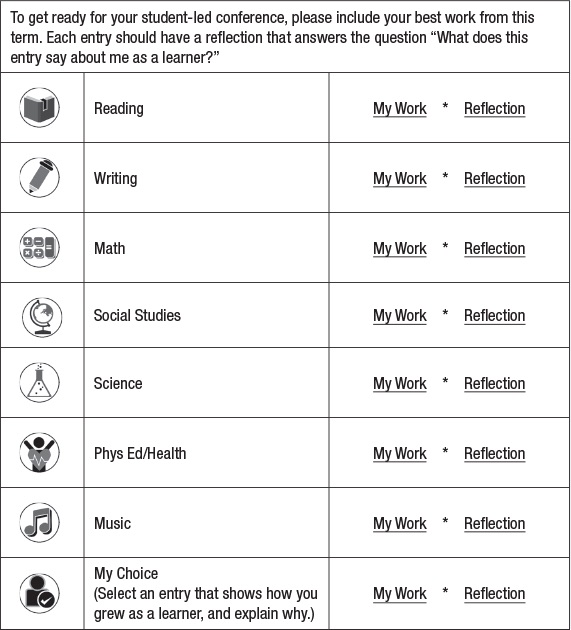A Comprehensive Guide to Badges and Portfolios
Demonstrating Student Mastery with Digital Badges and Portfolios
By David Niguidula
(ASCD, 2019 – Learn more)

For most educators, the idea of portfolios is nothing new. For many, digital badges aren’t either. As a result, many educators would probably skip reading David Niguidula’s book Demonstrating Student Mastery with Digital Badges and Portfolios. That would be a mistake.
A big one.
Niguidula goes beyond theory and provides a multitude of authentic examples, practical applications, and thoughtful considerations for the development and use of digital badges and portfolios in education. The sheer scope of his exploration of badges and portfolios makes this book an excellent read both for educators who have some experience with badges and those who are reading about them for the first time.

The introduction lays out the book nicely, providing definitions and a roadmap for readers, and describing chapter placement in the context of when various conversations should occur. It makes for an easy, well-organized read that underscores the importance of planning and collaboration when developing digital badges and portfolios.
Chapter 1: Setting the Vision
The first chapter in the book provides an overview of portfolios. Included in this section are terms, definitions, and reasons why portfolios are worthwhile. Emphasizing the importance of collaboration and a common vision, the chapter addresses two essential questions: “What does mastery look like?” and “What can portfolios tell us about students as learners and as individuals?” (7).
Chapter 2: Defining Badges
Delving deeper into the importance of establishing a common vision of student expectations, Chapter 2 focuses on the essential question “What do we want our students to know and be able to do?” (24). Niguidula explores the many types of digital badges that can be created to represent students’ learning, and he also makes it clear that those looking to embark on the digital badge journey need to begin with the end in mind. The chapter provides a multitude of considerations for a large variety of badge types, and is meant to be the focus of conversations before a school year begins.
Chapter 3: Creating Portfolio Worthy Tasks
The third chapter in the book addresses three essential questions: “How do students earn the badges?”, “What goes into the portfolio?”, and “How do we create portfolio-worthy tasks?” Not only does this chapter provide examples, ideas, and considerations by subject area, it also breaks down types of assignments that educators might want to have included in portfolios and suggests protocols for ensuring their validation.
Chapter 4: Effective Feedback with Schoolwide Rubrics
Meant to be a focus throughout the school year, Chapter 4 explores how schoolwide rubrics, calibration, and reflection help schools answer the essential question “How do we decide what is ‘good’ or, at least, ‘good enough’?’” (79). It provides considerations for rubric development, potential problems, examples, and specific instructions on how to calibrate assessments to inconsistencies. In addition, it also reiterates the importance of self-assessment and reflection and discusses strategies to help students reflect on their learning.
Chapter 5: Tours: Student Presentations of Portfolios
The focus of the fifth chapter is the essential question “How do students present their best work?” (99). Niguidula shares a variety of ways students can share their portfolios with others through badge tours. All badge tour types that he describes include two essential components: evidence and reflection. The chapter also includes examples, rubrics, and presentation protocols.
Chapter 6: Creating a Badge- and Portfolio Friendly School Culture
The final chapter of the book discusses how to make badges and portfolios a part of a school’s culture, rather than simply an initiative, by exploring the questions “How do we make sure badges and portfolios are valued?”, “How do we build on what we already have?”, and “What else has to change?”
There is no question that digital badges and portfolios can help personalize and propel learning; however, an implementation initiative needs to fit the circumstances of each district. Setting a purpose is key. Niguidula shares some purposes that work well and some that do not. He also provides insights on where to begin, how to grow the initiative, and what needs to be done to sustain it.
After sharing uses of digital portfolios for teachers and administrators, including connecting digital badges to other initiatives, the chapter ends by going back to the beginning, reminding us that the best learning activities do not start with technology, they start with education….and I could not agree more.
Final Thoughts
As a teacher who has explored using digital badges in my room at some level, even experimenting with Badge List with my students, I loved this book (and I am sure the Post-It notes company was happy I did!).
I have never used so many stickies to jot down ideas while reading a book! I even went as far as writing in the margins, underlining and circling text, and folding the page corners of the book (all things I have a hard time doing overall).
Truly, this was an excellent read that was well worth my time, giving me a great deal to think about as I refine my own practices with standards-based grading in my classroom. Rarely do I find books that ignite my passion and my mind the way this book did, and I cannot wait to have more of my colleagues read it so we can work together in reimagining portfolios and assessment in our school.
If you’re interested, here’s an archived ASCD webinar with the author.
Jennifer Savery is currently serves as a middle school teacher, technology integrationist, new teacher mentor, and Authentic Intellectual Work anchor in the Humboldt Community School District in Humboldt, Iowa. In her 25-year career, she has taught both high school and middle school English and Spanish, worked with both high school and middle school at-risk students in success centers, facilitated graduate programs in Educational Leadership and Development at Southwest Minnesota State University, earned her principal licensure at the Iowa Principal Leadership Academy, and enjoyed teaching in both Wisconsin and Iowa. Jennifer is passionate about assessment and utilizing technology for learning.



































